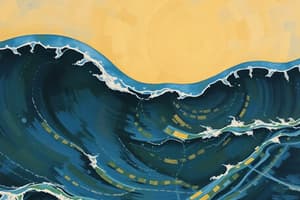Podcast
Questions and Answers
What are the three main categories that effects of earthquakes can be divided into?
What are the three main categories that effects of earthquakes can be divided into?
- Tsunamis, seiches, fires
- Landslides, fault creep, ground subsidence
- Ground failure, indirect effects, ground shaking (correct)
- Surface rupture, ground cracking, soil liquefaction
Which of the following is NOT an indirect effect of earthquakes?
Which of the following is NOT an indirect effect of earthquakes?
- Fires
- Ground failure (correct)
- Tsunamis
- Seiches
What type of ground failure involves the movement of the ground surface at a location where geological fissures or faults slip slowly or suddenly?
What type of ground failure involves the movement of the ground surface at a location where geological fissures or faults slip slowly or suddenly?
- Surface faulting (correct)
- Soil liquefaction
- Ground subsidence
- Landslides
Which type of ground failure involves rocks breaking through to the surface due to relative movement on both sides of a fault?
Which type of ground failure involves rocks breaking through to the surface due to relative movement on both sides of a fault?
Why is sudden movement in ground failures considered more damaging?
Why is sudden movement in ground failures considered more damaging?
What is the main cause of ground subsidence during earthquakes?
What is the main cause of ground subsidence during earthquakes?
Which type of soil is most susceptible to soil liquefaction?
Which type of soil is most susceptible to soil liquefaction?
What type of wave is generated when an earthquake causes vertical movement of the seafloor?
What type of wave is generated when an earthquake causes vertical movement of the seafloor?
What is the main reason tsunamis are difficult to detect in the open ocean?
What is the main reason tsunamis are difficult to detect in the open ocean?
What causes seiches, earthquake-induced waves in enclosed bodies of water?
What causes seiches, earthquake-induced waves in enclosed bodies of water?




